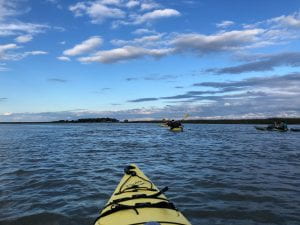This weekend, my roommates and I went kayaking in an estuary by James Island. It was my first time kayaking, and I was continuously awestruck throughout the entire two-hour trip by the peacefulness and beauty of the ecosystem. The waters were calm even as the marsh grass blew in the breeze, and you could taste the salt in the air. The estuary was near a road connecting neighborhoods on the island, so the occasional car was heard, and there were power lines running over some of the trees. However, at times there was no other sound than our paddles hitting the water, and I wish I could have stayed out on the water all day.
I normally try my best to stay off of my phone as much as possible throughout the day, but I promised my dad some pictures as the trip was a present, so that was the only reason I was on my phone. It was a beautiful experience to just paddle through the waters with my best friends while scanning the cloudy sky as the sun set. We even saw a couple dolphins swim through the estuary less than ten feet from our kayaks!
As I live on campus downtown, I do not have the opportunity to experience nature in this capacity on a regular basis. I also do not have my car with me during the semester, so unless I pay for an Uber or Lyft, I tend to find myself pretty confined to the peninsula. Even the “nature” downtown is cultivated and kept tidy by groundskeepers for residents and tourists. The parks we have were designed to be beautiful green spaces, but they were designed by humans, which kind of takes away from their natural aspect.
Kayaking, however, allowed me to experience nature without the sounds of cars starting, ambulances blaring past, or cell phones ringing. Sadly, I feel like my connection to nature has decreased over time as I grew older and became busier, but spending a couple hours on the water this past Saturday reminded me of how much I love the sun and trees and salt water. I am originally from northeast Ohio, and feeling the sun warm my skin reminded me of how excited I was to move to Charleston, where the sun is always warm and bright and not constantly hidden by clouds. I feel like I have lost the connection from my youth, when the best days were the ones spent with bare feet running on the bright green grass. This weekend reminded me of the importance of that connection and the need to restore it.
I believe that most of the people living on the Earth today have lost their connection with nature through sitting behind cubicles and under fluorescent lights, always hiding behind bright computer monitors and phone screens. Many of the issues plaguing the world would cease to exist if people would look up and recognize the nature we destroy every second of every day through our consumeristic habits and materialist lives. If we continue fueling our linear economy, creating mass amounts of waste, throwing away overproduced food, and expanding animal agriculture, soon there will no longer be any nature for us to appreciate, and that is such a terrible thought. 









 *
*